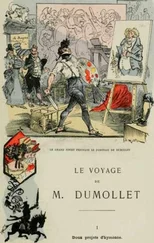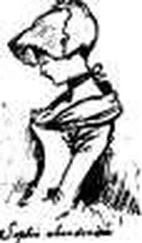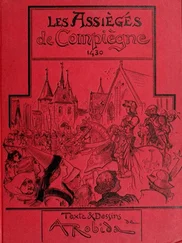Albert Robida - Yester-year; ten centuries of toilette from the French of A. Robida
Здесь есть возможность читать онлайн «Albert Robida - Yester-year; ten centuries of toilette from the French of A. Robida» весь текст электронной книги совершенно бесплатно (целиком полную версию без сокращений). В некоторых случаях можно слушать аудио, скачать через торрент в формате fb2 и присутствует краткое содержание. Жанр: Старинная литература, на английском языке. Описание произведения, (предисловие) а так же отзывы посетителей доступны на портале библиотеки ЛибКат.
- Название:Yester-year; ten centuries of toilette from the French of A. Robida
- Автор:
- Жанр:
- Год:неизвестен
- ISBN:нет данных
- Рейтинг книги:4 / 5. Голосов: 1
-
Избранное:Добавить в избранное
- Отзывы:
-
Ваша оценка:
- 80
- 1
- 2
- 3
- 4
- 5
Yester-year; ten centuries of toilette from the French of A. Robida: краткое содержание, описание и аннотация
Предлагаем к чтению аннотацию, описание, краткое содержание или предисловие (зависит от того, что написал сам автор книги «Yester-year; ten centuries of toilette from the French of A. Robida»). Если вы не нашли необходимую информацию о книге — напишите в комментариях, мы постараемся отыскать её.
Yester-year; ten centuries of toilette from the French of A. Robida — читать онлайн бесплатно полную книгу (весь текст) целиком
Ниже представлен текст книги, разбитый по страницам. Система сохранения места последней прочитанной страницы, позволяет с удобством читать онлайн бесплатно книгу «Yester-year; ten centuries of toilette from the French of A. Robida», без необходимости каждый раз заново искать на чём Вы остановились. Поставьте закладку, и сможете в любой момент перейти на страницу, на которой закончили чтение.
Интервал:
Закладка:
The busked corset, tlien called ' basquine,' appeared at this period. Very probably there was a separate apparatus worn underneath the bodice, but the bodice itself was stiffened by means of whalebone; at all events, the confused descriptions of the basquine, which are all we have, lead us to think this may have been so.
Certain modes of adjusting the bodice, to which objection might well be taken, had been imported from licentious and effeminate Italy, and men also went bare-necked. Large sums were expended in jewellery and goldsmith's work, for the ornamenting of head-dresses— the 'attifet/ the 'chaperon,' and the 'toque.' Queens, noble ladies, and bourgeoises, impoverished themselves by buying gold chains, enamelled trinkets, pearls, and other gems.
La belle Ferronniere, one of the mistresses of Henri Quatre, who succeeded the Duchesse d'Etarapes, invented the fashion of wearing a carbuncle hung on a gold thread, in the middle of the forehead. One more jewel to be worn, when the head-dress, the bodice, and the girdle, were ah'eady laden with sparkling stones ; what a charming idea ! The head-dress à la Ferronnière achieved an immediate success.
Several additions to dress, hitherto unknown, came into use at this period. For summer there was the feather-fan, a pretty pretext for goldsmith's work in the mounting ; for winter there was the muff. According to the royal decree, black muffs were for the bourgeoises, coloured ones for noble ladies only. Parasols were also imported from Italy, but did not ' take ' to any great extent ; they were too heavy.
But now the extinguisher of ' the Reform ' popped down upon the brilliant epoch of the Valois King, and a dark, troubled time set in.
Fashion, which had been brilliant, lavish, and superb in its sumptuous amplitude during the reign of Francis I., a chivalrous, prodigal, and ostentatious prince, in an age of dash
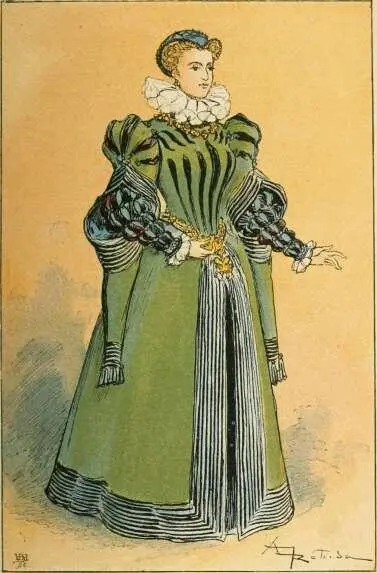
sous iinxRi II.
and 'bravery,' and of licence also, was about to change its character suddenly, and to become as austere as it had been showy, as
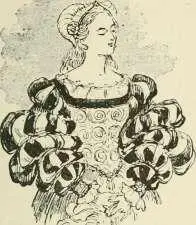
Slashed sleeves.
sombre and melancholy as it had been brilliant and full of colour.
At the beginning of the reign of Henri II. there was a tough struggle between the gloomy and the gay fashions, but the former very soon beat the latter, and by degrees the bright and frivolous modes vanished, and were succeeded by dark colours, eventually indeed by plain black.
The times Avere troublous, and tending towards blackness too. In the train of ' the Reform,' -with its religious dissensions, its wars of sermons and controversy in the first place, came actual war, waged with cannon and arquebus, stake and gallows.
In 1549, Henri II. opened hostilities against luxury in dress, by an edict interdicting a great number of ornaments and stuffs, trimmings, borders, gold lace, cloths of gold and silver, satins, &c., and strictly regulating the fashion. This edict prescribed the kind and quality, and even the colours, of the stuffs to be worn by the different classes.
The right of wearing a complete vesture, both upper and under, of crimson hue, was reserved to princes and princesses exclusively ; the nobles, male and female, were permitted to display that brilliant colour in only one article of their costume.
Ladies of the next rank had the right of wearing gowns of every colour except crimson, and their inferiors miglit wear a dull red or black. The same sliding scale was appointed for stuffs, from satins and velvets to plain cloth. Loud cries of lamentation resounded throughout the country \\hen the edict was about to be enforced.
The ladies of France, from north to south, from east to west, closed up their ranks, and bravely defended, inch by inch, their stuffs and their colours, their jewels and their trinketry, disputing with the agents of authority, and advancing a thousand ingenious reasons for keeping everything they had got.
The King had to resume his pen, and to complete his edict by a series of explanatory clauses, detailing point by point what was permitted and what was prohibited. He made certain concessions to the ladies, and allowed them a few little coquettish indulgences; but outside of these what was forbidden remained forbidden, and the sumptuary law was rigorously enforced.
" Le velours, trop commun en France, Sous toy reprend son vieil lionneiir," says Ronsard, in a letter to the King, in which he praises the reformatory decrees of Henri II. Catherine de Médicis, that gloomy princess, whose blood poisoned the blood of the Valois, the murderess who died full-fed upon crime, now predominated over the Court of France—it was still brilliant —like a black phantom, em-The head-dress of blematic of the approaching
Catherine de Médicis. era of crime and massacre.
She left the artifices of coquetry to the Court ladies and to Diane de Poitiers, her husband's mistress, the supreme beauty, the semi-mythological goddess of the Renaissance, of whom Jean Goujon made a statue, even

THE RENAISSANCE.
as Canova long afterwards sculptured Pauline Borghese, another princely beauty. The prettiest creations of the age are dark-coloured costumes, elegant but severe, composed of harmonies in gray, or harmonies in black and white, the colours of Diane de Poitiers.
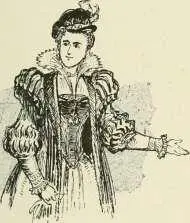
Uoder Heuri II.
At the death of Henri II,, Catherine assumed the costume of a widow, and this she never laid aside. Surrounded by a swarm of brilliant young beauties, her Maids of Honour, who were called " The Queen's flying squadron "— a squadron that served her to better purpose in her innumerable schemes than many squadrons of swash-bucklers — she j^assed throuçjh the three troubled reio-ns of the kings her sons in black from head to foot, black like the night, black like her own soul.
A wide skirt in black stuff, a black, pointed bodice, ^Yith large, black, wing-sleeves attached to the shoulders, a black collar, ruff-shaped, and for head-dress a sort of hood or toque, with a front which comes down in a point upon a brow busy with dark designs ; such was her costume.
It seems that it was Catherine who imported ruffs into France, when she arrived from Florence for her marriage ; and these ruffs (fraises) were adapted at once by both men and women.
Ruffs were of all sorts, moderate and outrageous, very simple ones in pleated lawn, and others in wonderful lace. The ruff was a charming invention, it had its drawbacks no doubt, like many another device of fashion, but its quaint sliapes, in fihny kice, formed a dainty frame to the faces of fair women, whicli looked out from gems iu a setting of fine workmanship.
The decorative elegance of the Renaissance was largely due to the master-pieces of the essentially feminine art of lace-making. The same artist who worked in bronze, in gold, or in silver, who carved wondrous decorations in stone on the façades of palaces, supplied the designs for ruffs ; lace had its Benvenuto Cellini, at Brussels, at Genoa, and especially at Venice, the chief centres of lace-making.
It was not until the time of Henri III. that the ruff assumed its full proportions. At first it was merely a gorget with round stiffened folds which encircled the throat from the collarbone to the ears, the harsh close-pleated ruff of a period of increasing gloom. Protestant austerity had been gaining ground rapidly, and although the Catholics retained their more facile manners and customs, the religious quarrel had become very bitter, and civil war brooded over France.
Читать дальшеИнтервал:
Закладка:
Похожие книги на «Yester-year; ten centuries of toilette from the French of A. Robida»
Представляем Вашему вниманию похожие книги на «Yester-year; ten centuries of toilette from the French of A. Robida» списком для выбора. Мы отобрали схожую по названию и смыслу литературу в надежде предоставить читателям больше вариантов отыскать новые, интересные, ещё непрочитанные произведения.
Обсуждение, отзывы о книге «Yester-year; ten centuries of toilette from the French of A. Robida» и просто собственные мнения читателей. Оставьте ваши комментарии, напишите, что Вы думаете о произведении, его смысле или главных героях. Укажите что конкретно понравилось, а что нет, и почему Вы так считаете.

